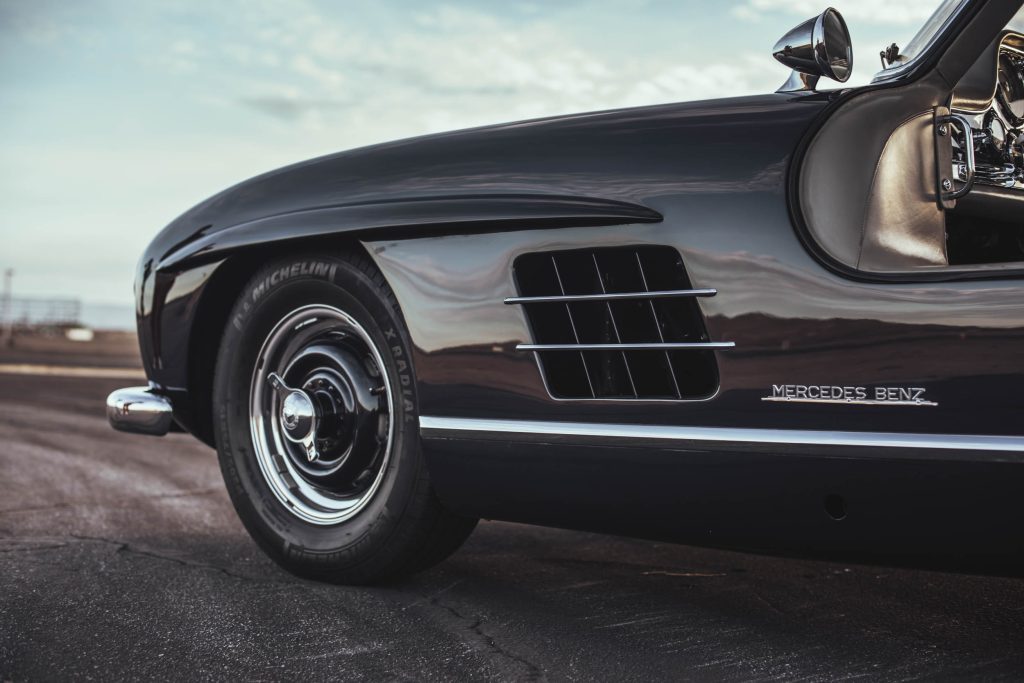You haven’t lived your best automotive life until you’ve reversed a Countach while sat on the sill and peering backwards, perfectly double-declutched a Vintage Bentley – or burbled through a crowd in a Gullwing with the doors up.
No need to tell anyone that it’s because the cabin is unbearably hot with them shut, or that the Gullwing doors only came about because the complicated chassis necessitated them. There’s a reason that this car is so revered and it goes beyond the iconic profile it forms with the doors open.

Mercedes-Benz had dominated Grand Prix racing in the 1930s, and when it began to recover from the destruction of World War 2 it started looking to return to motor sport. Sports cars were the achievable way to come back and so chief designer Rudolph Uhlenhaut devised a tubular spaceframe to carry relatively conventional running gear, including the company’s straight-six engine. Initially it was clothed in a low, wide, curvy body that would have been aerodynamic by the standards of the day but wasn’t great aesthetically.
This was the 300S race car of 1951, which proved a success even up against the more powerful, purpose-built Jaguars and Ferraris of the day. And it was this car that spawned the better looking and more civilised 1954 300SL W198 that we now know as the Gullwing, via the earlier gullwing-door W194 sports racer.

Twenty-nine Gullwings were bodied in aluminium, one was made in fibreglass and the rest were steel but with aluminium bonnet, doors and boot lid. With the mostly steel body version, overall weight was around 1500kg, which was heavy by the sports car standards of the day. At least the extra power gained by fuel injecting the engine compensated, endowing the Gullwing with 240bhp. The coupé continued until 1957, at which point production ended and the 300SL Roadster was launched, which used the same running gear and similar chassis, and lasted until 1963, which is quite a run for such specialised and expensive cars. In that time, just 1500 Gullwings and 1858 Roadsters were built.
Fifty years after the first Gullwing rolled out of Stuttgart I was lucky enough to be invited to a special golden anniversary celebration, driving several examples through the Black Forest. I still remember emerging early from the hotel to be greeted by a line of Gullwings noisily idling, condensation wisping from their exhausts and each one attended to by a white-overalled Mercedes-Benz Classic technician.

The drive was truly special, through winding roads to a frankly terrifyingly cramped underground car park in the spa town of Baden-Baden at the conclusion of day one. It also included a memorable blast along the autobahn on the second day, after which we were all presented with a model Gullwing in a tubular glass presentation case. That souvenir still sits directly behind my desk, 20 years on, which should tell you something.
Incredibly, within weeks of gorging on that Black Forest experience I was back in a Gullwing, this one an alloy-bodied version, on a private track in the UK. I was mostly there to drive the Gullwing and its sister Roadster for photography but it was a great reminder of the Gullwing’s strengths and strange foibles – and there are plenty of both. Further drives in more recent years have only confirmed that.
It starts, predictably, with the clamber over those wide, high sills, which cover the lattice of thin chassis tubes. Those top-hinged doors do make access easier, as does the clever hinged steering wheel, but there’s no getting away from the fact that the footwells are too cramped and a little short in length to be truly comfortable. Still, the tartan-trimmed bucket seat is comfortable even if – with the doors closed and the tall instrument binnacle a little too close – the general impression is of mild claustrophobia.



A Gullwing engine always seems to need a quick churn of the starter to prime the mechanical injection before bursting into noisy life, despite the secondary electric fuel pump intended to help cold starts and hot running. Aside from the then-innovative injection and complicated dry sump oil system, this is a fairly straightforward six-cylinder, with a chain-driven single overhead camshaft and two valves per cylinder. It’s a big heavy lump though, despite its relatively modest 3-litre capacity. It sits in the engine bay canted over to one side to reduce height; a necessity because the intake tracts are directly above the exhausts rather than on the opposite side of the head.
There’s always seems to be a bit of mechanical thrashing from the camchain and the ancillaries but the Gullwing happily sits at idle, the only sign of its high state of tune being the revs hunting up and down occasionally. The clutch is firm but not overly heavy and the neat little gearlever slots into first with a short precise action, easier still when the transmission has warmed up.
There’s loads of torque so it’s not long before the engine itself is forgotten. What isn’t forgotten is the reputation of the rear suspension… It’s a swing axle system just like, say, a Beetle or Triumph Herald in principle, with exactly the same characteristics. In its favour, it’s extremely simple with a driveshaft either side of the differential, pivoted only at their inner ends, not at the wheels. What goes against this design is the tendency for the rear wheels to ‘jack up’, raising the centre of gravity and not keeping the tyre tread flat on the floor. This doesn’t help maintain grip of the road surface, which is always in the back of your mind when driving a 300 SLR.


The front suspension features conventional double unequal length wishbones, which does exactly the job it’s meant to do, and with coil springs and telescopic dampers all around, the ride is good though firm, as you’d expect. But in tight turns particularly, it sometimes feels as though the front and rear are playing to entirely different tunes. What you absolutely don’t do is go barrelling into a corner and brake late because that will allow the rear wheels to jack up, reducing the tyres’ contact patch and so lessening the grip, just when you need it most.
On those twisty bits of the Black Forest roads I remember sticking obsessively to slow in, fast out cornering, though ‘fast’ was probably a relative term given my lack of familiarity with the car initially. Still, as far as I know there was only one mishap on that press trip, and that was caused by a lifestyle magazine journalist getting a high heel stuck under the pedals as she approached a bend. It didn’t end as badly as it might have…
She could just have blamed the brakes, because after modern cars the large drums take some getting used to. They work – but only just, given the performance of the Gullwing. There will always be a right-thigh-trembling moment when driving one of these at speed.

It all comes together though, and it’s not long before you learn what works and what absolutely doesn’t. Use the torque, practice your smoothest possible driving, leave time to brake and revel in the quality of every touch point, right down to the precision of the quarterlight window catches, which you absolutely will need, because boy does a Gullwing get warm inside.
Funny thing is, what I remember most about any of my Gullwing drives is the last 50km of that first experience in Germany, when I hit the autobahn at speed, powering along the fast lane, marvelling as aggressive-looking modern saloons meekly moved aside – and that never happens on German autobahns. Such is the presence of a Gullwing.
Read more
Official: Mercedes-Benz 300 SLR “Uhlenhaut coupé” sold for a record £115 million
Driving the Mercedes 300 SLR “Uhlenhaut coupé” – the world’s most expensive car
Drive or display? 5 supercars that attracted collectors, as well as drivers











Registration SL 300 belonged to Aberdeen Butcher, E. C. “Eddie” Matheson. I have photos of it and had a ride. His was silver. Lovely engineering but remember it as having loud gear noise and brutally quick. Often wonder where it is now?
A true chef d’œuvre.
What a beautiful car